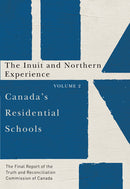Description
Canada's Residential Schools: The Inuit and Northern Experience, Volume 2 addresses topics that are often ignored in the discussion of residential schooling. This title is part of The Final Report of the Truth and Reconciliation Commission of Canada
The 1950s saw a dramatic expansion of residential schooling in northern Canada and the creation of a system in which Inuit children were sent to residences that could be hundreds of kilometres from their home communities. This title demonstrates that residential schooling followed a unique trajectory in the North. As late as 1950 there were only six residential schools and one hostel north of the sixtieth parallel. Prior to the 1950s, the federal government left northern residential schools in the hands of the missionary societies that operated largely in the Mackenzie Valley and the Yukon. It was only in the 1950s that Inuit children began attending residential schools in large numbers. The tremendous distances that Inuit children had to travel to school meant that, in some cases, they were separated from their parents for years. The establishment of day schools and what were termed small hostels in over a dozen communities in the eastern Arctic led many Inuit parents to settle in those communities on a year-round basis so as not to be separated from their children, contributing to a dramatic transformation of the Inuit economy and way of life. Not all the northern institutions are remembered similarly. The staff at Grandin College in Fort Smith and the Churchill Vocational Centre in northern Manitoba were often cited for the positive roles that they played in developing and encouraging a new generation of Aboriginal leadership. The legacy of other schools, particularly Grollier Hall in Inuvik and Turquetil Hall in Igluligaarjuk (Chesterfield Inlet), is far darker. These schools were marked by prolonged regimes of sexual abuse and harsh discipline that scarred more than one generation of children for life. Since Aboriginal people make up a large proportion of the population in Canada’s northern territories, the impact of the schools has been felt intensely through the region. And because the history of these schools is so recent, the intergenerational impacts and the legacy of the schools are strongly felt in the North.
The 1950s saw a dramatic expansion of residential schooling in northern Canada and the creation of a system in which Inuit children were sent to residences that could be hundreds of kilometres from their home communities. This title demonstrates that residential schooling followed a unique trajectory in the North. As late as 1950 there were only six residential schools and one hostel north of the sixtieth parallel. Prior to the 1950s, the federal government left northern residential schools in the hands of the missionary societies that operated largely in the Mackenzie Valley and the Yukon. It was only in the 1950s that Inuit children began attending residential schools in large numbers. The tremendous distances that Inuit children had to travel to school meant that, in some cases, they were separated from their parents for years. The establishment of day schools and what were termed small hostels in over a dozen communities in the eastern Arctic led many Inuit parents to settle in those communities on a year-round basis so as not to be separated from their children, contributing to a dramatic transformation of the Inuit economy and way of life. Not all the northern institutions are remembered similarly. The staff at Grandin College in Fort Smith and the Churchill Vocational Centre in northern Manitoba were often cited for the positive roles that they played in developing and encouraging a new generation of Aboriginal leadership. The legacy of other schools, particularly Grollier Hall in Inuvik and Turquetil Hall in Igluligaarjuk (Chesterfield Inlet), is far darker. These schools were marked by prolonged regimes of sexual abuse and harsh discipline that scarred more than one generation of children for life. Since Aboriginal people make up a large proportion of the population in Canada’s northern territories, the impact of the schools has been felt intensely through the region. And because the history of these schools is so recent, the intergenerational impacts and the legacy of the schools are strongly felt in the North.


